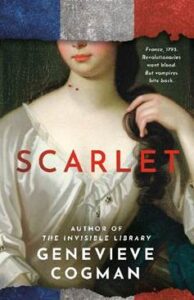It is a truth universally acknowledged that a widely known classic must be in want of some reimagining, reconstruction and general exploration (to misquote Pride and Prejudice). However, different authors reimagining the same original work may go to different levels or poke at different areas when looking for tools they can work with, images they can use, and inherent issues to explore.
The surface elements of the Scarlet Pimpernel stories are straightforward enough:
- a heroic nobleman (Sir Percy Blakeney)
- rescues innocents from peril (the French Revolution)
- while pretending to be a fashionable idiot (“Lud, my cravat!”)
- while juggling a loving wife (Marguerite), romantic misunderstandings, friends, and a malignant adversary (Chauvelin)
- and having some sort of personal token, such as a little red five-petalled flower
In the setting, we have:
- a dystopic location (France during the Revolution)
- innocent victims (condemned to the guillotine)
- outsiders who can help (the League)
This basic set of elements has been reused multiple times in fiction, to the extent that if I were to mention “hero fights crime while his civilian identity is a fashionable twit”, then many people’s first impulse would probably be to point at Batman, or maybe Zorro. Rescuing innocents from dangerous situations is also something which any hero (though perhaps not any protagonist) would be automatically expected to do by the reader: in fact, if they didn’t, it would be a major plot point for the narrative. Likewise, most heroes have an accompanying cast including a romantic partner and an ongoing villain or villains. (What would Batman be without the Joker, or Valjean without Inspector Javert?) There have also been transplantations to other times and places, where the basic concepts have remained the same – such as the movie Pimpernel Smith, which outright references the original story.
It’s up to the author to choose which parts of the original they want to use – whether its character details, setting details, or basic assumptions baked into the original plot which might be seen differently nowadays. What can the author find which Orczy didn’t necessarily intend but which can be argued as a core character or setting element, and then cheerfully exploited?
Sir Percy’s claimed motivation is what he describes as “the love of the game” – he continually declares throughout the stories that he and the League are involved in all this as a matter of “sport”. I believe the intended unspoken meaning here is that all the League consider what they’re doing to be the “right thing”, but are being very stereotypically English upper class in claiming that it’s just “for sport”. However, it’s also very easy to read Sir Percy as an undiluted thrill-seeker, a danger junkie who is constantly sneaking off in disguise into greater and greater perils, while reassuring himself that it’s all to save the hapless innocents who face the guillotine. Following this thread, one can see him leading the rest of the League into danger, and ignoring his responsibilities to wife and family – the wife he claims to love – “for the greater good”, but subconsciously for just one more thrilling episode of narrowly avoiding the Revolutionary Guard and the clutches of Chauvelin.
Likewise, other key characters have interesting traits which make for fruitful exploration. Marguerite Blakeney (Sir Percy’s wife) is shown as someone who’s prepared to go to great lengths to protect the people she loves. Prior to the stories, she reported some aristocrats to the Revolutionary authorities because they ordered her brother beaten: as a result they were guillotined, though it’s fair to say that she didn’t expect such severe consequences. In the stories, she’s prepared to sell out the Scarlet Pimpernel in order to save her brother Armand (not knowing at the time that the Pimpernel is actually her husband). Later on, she puts herself in grave danger (and drags another League member, Sir Andrew Ffoulkes, into the situation) in order to save her husband. These are noble and heroic traits – but they can also be extrapolated into a darker character. Marguerite Blakeney is willing to do absolutely anything to save the people she loves. How far might that extend?
Beyond that, we have what might be the biggest elephant in the room to modern readers – the question of class. Why, the modern reader might ask, is it (almost) always hapless aristocrats who are saved from the guillotine? What about all the poor innocent commoners who are arrested, tried and sentenced, and who didn’t necessarily deserve it? (To be fair, Orczy does have quite a number of decent lower-class people who are portrayed as enduring the excesses of the Revolution rather than celebrating it, and from time to time the League rescues them as well as the more numerous aristocrats.) If it’s just that Orczy never wrote the League thinking beyond their own boundaries, their own class-based prejudices, then what would happen if they did start thinking on a wider scale?
And if it really was such a vital mission, how can the League not spend every waking hour “on the job”? Should they be bitterly remembering all the people they couldn’t save? In practical terms, what about the increasing number of rescued aristocrats in England who might possibly remember the face of someone who helped them, and who could theoretically encounter such a nobleman during the regular parties and salons expected in Society? Given the increased paranoia at the time in England about “sedition”, “treason” and “rebellion”, what might happen if someone started looking suspiciously at these loitering aristocrats with no occupations, no alibis, and a suspicious amount of knowledge of France? Who ultimately funds the League’s operations?
How, one might ask, does any of it work?
And to the author, that’s not a problem. That’s an opportunity.
***


















